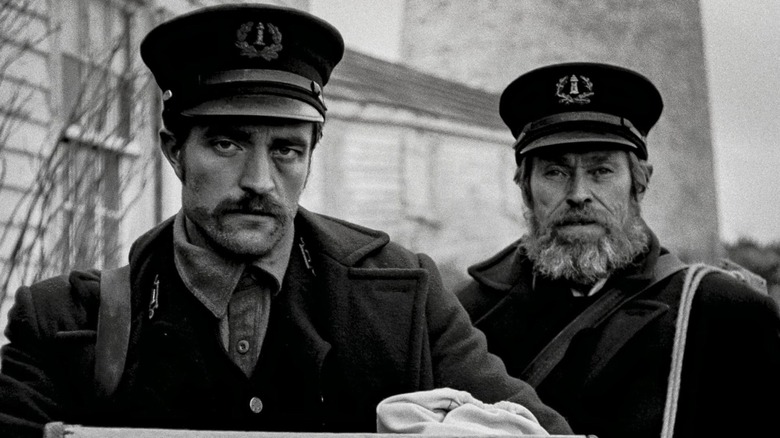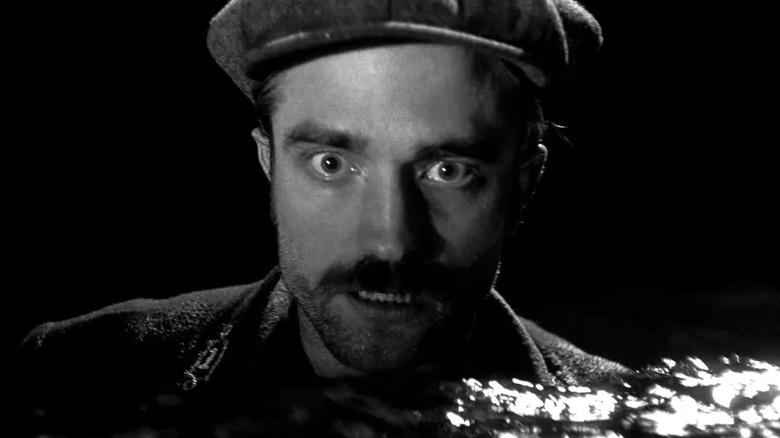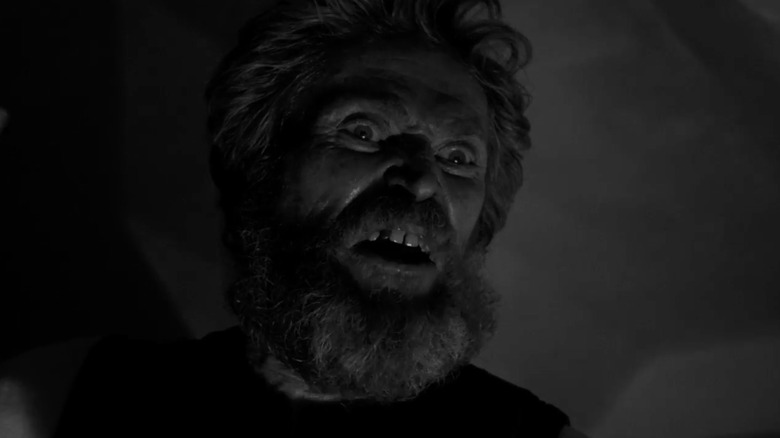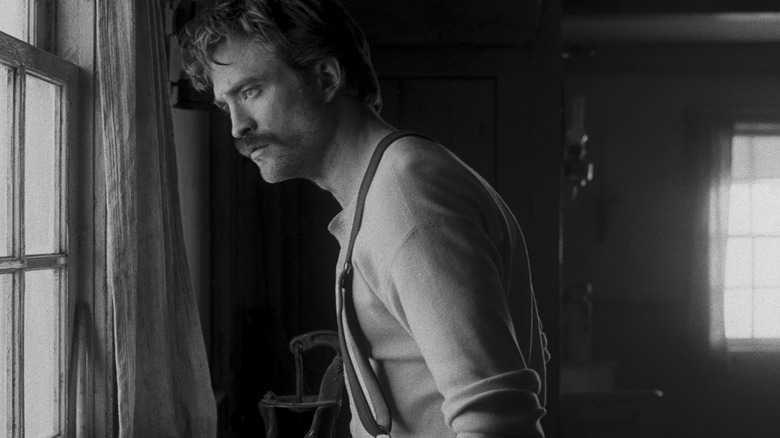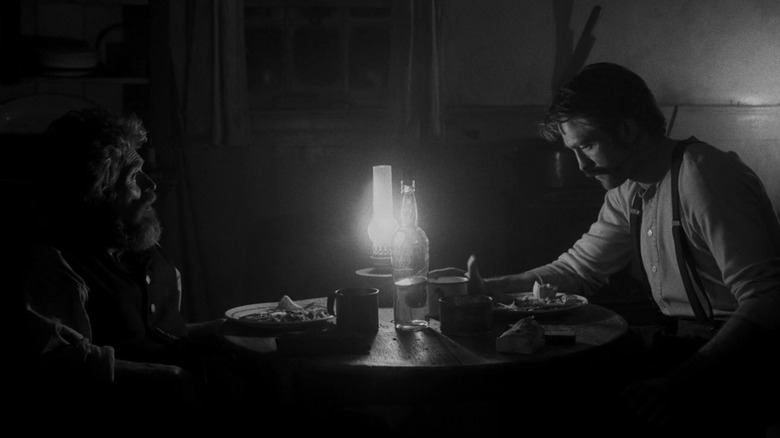Robert Eggers Wasn't Afraid To Get Rough While Filming The Lighthouse
We may receive a commission on purchases made from links.
Robert Eggers' 2019 film "The Lighthouse" is easily one of the best films of that year, which is saying something as 2019 also contained "Portrait of a Lady on Fire," "A Hidden Life," "The Souvenir," "Pain and Glory," "The Irishman," "Little Women," "Midsommar," and many others. It was a ridiculously strong year for film.
Notable for its grit and filth, "The Lighthouse" tells the story of two men, one novice (Robert Pattinson) and one expert (Willem Dafoe), who must tend to a lighthouse on an isolated island sometime in the 1890s. Their job is precise, labor-intensive, and smelly. Birds attack them, booze is in short supply, and saltwater gets everywhere. The only things that can grow are foot fungus and animosity. By the end of the film, they are drinking things that aren't booze, they are having affairs with hallucinated mermaids, and both men are more or less insane. It's glorious.
Eggers, who also directed "The Witch" and "The Northman," constructed a unique look for "The Lighthouse" that falls somewhere between a 1970s still photography exhibit and the horror films of 1919. The film was presented in the Academy standard 1.37:1 aspect ratio as well, adding to its antique feeling. This involved bringing some rare, unusual cameras to the film's remote location — production took place in a remote fishing village in Nova Scotia — and shooting incredibly difficult scenes of his actors lying in mud, baring cold, wet weather, and delivering lines with sand in their mouths. It was brutal.
The tech
According to American Cinematographer Magazine, cinematographer Jarin Blaschke shot "The Lighthouse" on Kodak's Eastman Double-X black-and-white 5222 film stock with a Panavision Millennium XL2 and 1930s-'40s Baltar lenses. He also used custom filters that "emulated early-1900s orthochromatic stock, which was sensitive to ultraviolet, blue and green light, but not red."
Orthochromatic film was a stock made with silver halide crystals, which tended to be more blue-sensitive. It was commonly used from the 1870s until 1906, and the process led to starker whites (skies were typically seen as pure white on ortho stock) and deeper blacks (the stock would turn red objects into black and deep gray). In 1906, panchromatic film was invented, which added dyes to the process, allowing the silver halide crystals to become more color-sensitive. The grades of gray became more varied after 1906, and film stock was made that way for a century thereafter.
Eggers and Blaschke had special cameras assembled using vintage lenses that needed to be rehoused, gear remotes, and the custom filters (actual orthochromatic film stock had likely disintegrated by 2019). Shooting in a rainy location with mix-tech cameras presented problems, and several crew members were not happy having to quickly make manual repairs and adjustments to several generations of camera technology. Eggers said to The Verge:
"Panavision rehoused all the lenses for us, and that took a bit of work. The gear remotes for focus pulling, there were a lot of issues. We broke a lot of rain-deflectors in the weather. Eddy McInnis, our awesome focus-puller, was like — the rain's coming, and he's got a flashlight in his mouth — and he's like, 'I'm trying to jam together three f****** eras of f****** camera equipment, all this bulls***! Raaarrr!' Good times."
The weather all but ensured that the lenses were going to fog up:
"[W]e broke a lot of rain deflectors, and there were a lot of takes we couldn't use because the lens was fogged. Take after take after take ... Rob had to walk into the Atlantic Ocean like 25 times, because the lens kept fogging on that shot."
Willem Dafoe
In one scene in "The Lighthouse," Willem Dafoe has to deliver a speech while Robert Pattinson is attempting to bury his character alive. Dafoe had to get down into a cold, wet, sandy pit, and dirt had to actually be thrown into his face and, inevitably, into his mouth. Eggers pointed out that the icy water Dafoe was lying in had the perfect visual shimmer, but that didn't improve Dafoe's mood:
"Willem was not a happy camper. He was really in a terrible mood and we couldn't do too many takes of that one. That water under him, if you notice it, it looks like just a nice texture. But he was lying in ice cold water on top of everything else he has to endure in that scene. And we shot it on day two. But Willem Dafoe is Willem Dafoe, so he did it, and I'm just a lucky man."
According to an interview Eggers gave with Rolling Stone, both Dafoe and Pattinson commented to him that the location was, at the end of the day, incredibly authentic. It was only that authenticity that allowed Eggers to do some of the more outré things he wanted:
Both Willem and Rob said to me at different points, 'If you remove the cameras, we are in the 1890s right now.' They did not have to imagine what is was like to be running a lighthouse and feel isolated and cold. And once you get that reality down ... that's when you can bring in the weird s***."
Robert Pattinson
Robert Eggers takes on a "just get it done" attitude while filming, and he recalls a time when he literally blasted Robert Pattinson in the face with water. This could not have been fun for Pattinson, who screamed at Eggers. Eggers, again from Rolling Stone, recalls:
"Look, some days, you have to film a sequence in which the rain is pounding down on someone and you're just turning the camera on what's happening. And other days, you occasionally have to spray Robert Pattinson in the face with a fire hose. You know, 'What the f*** is happening here, I feel like I'm getting sprayed in the face with a fire hose!' 'Well, yes, because you are.'"
Speaking with Interview Magazine, Pattinson recalled the same event going just about the same, but also recalling that he came very close to slugging Eggers:
"That's the closest I've come to punching a director. However much I love Robert, there was a point where I did five takes walking across the beach, and after a while I was like, 'What the f*** is going on? I feel like you're just spraying a fire hose in my face.' And he was like, 'I am spraying a fire hose in your face.' It was like some kind of torture. It definitely creates an interesting energy."
Like a documentary
Because of the brutality of the shoot, and the authenticity of the images and setting, Robert Eggers commented that "The Lighthouse" was almost like a documentary. He admits to feeling brutalized himself, mostly by himself. From Rolling Stone:
"It was tough. There were days when I wanted to die, and I love the cold. Even the Nova Scotia crew we used ... all they do is work on European adaptations of 'Moby-Dick' and 'The Sea Wolf,' so this is their specialty. And by the end, they were saying, 'Yeah, this is the hardest shoot we've done by far.'"
But everyone seems to have been at peace with — or at least knew — what they were doing going in:
"But this was what we signed up for. I like researching things to the point where I get to step into my own personal Disneyland — or maybe Miseryland is a better term. It's not just an indulgence, though. It really is [to] make you feel as closely rooted in the times as possible."
"The Lighthouse" is available to stream on Prime Video, on Kanopy, and on Spectrum on Demand. Eggers' next film, "The Northman," is due in theaters on April 22, 2022.
